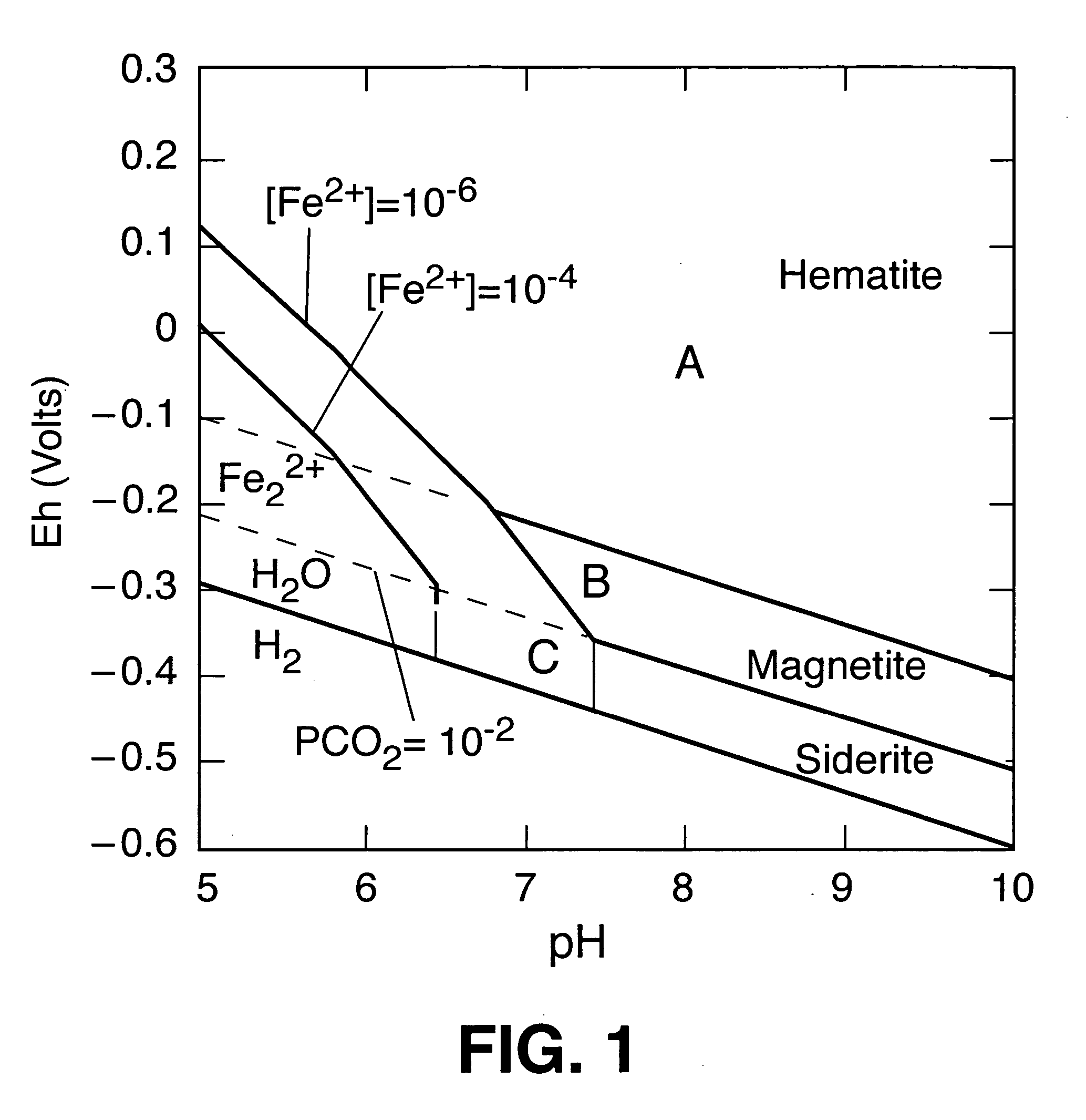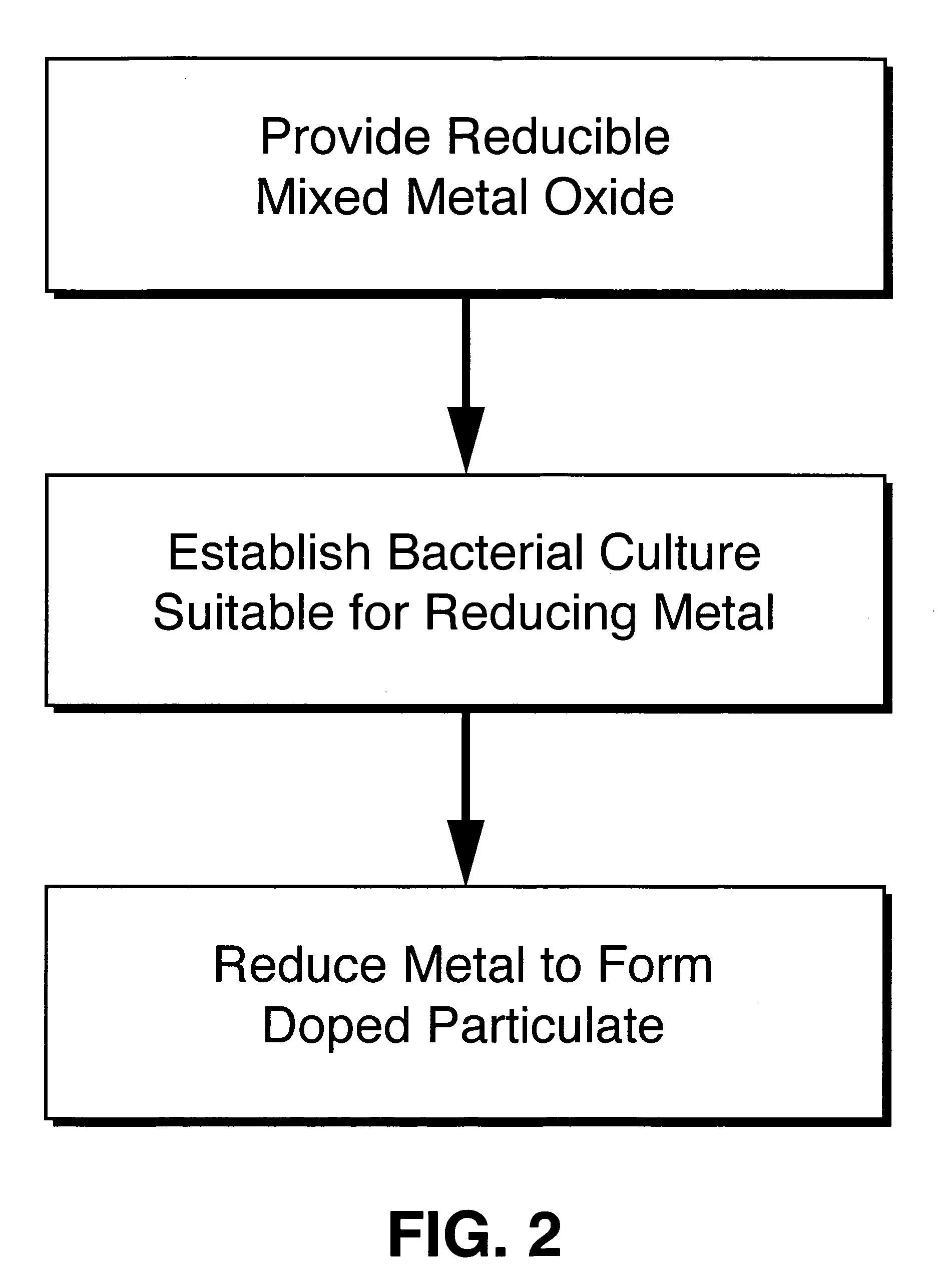Fermentative process for making inorganic nanoparticles
- Summary
- Abstract
- Description
- Claims
- Application Information
AI Technical Summary
Benefits of technology
Problems solved by technology
Method used
Image
Examples
example i
[0029] Mixed-metal oxyhydroxide was prepared by slowly adding a 10 M NaOH solution into a mixture of 0.4 M FeCl3.6H2O solution that contained another metal salt such as MnCl2.4H2O, NiCl2.6H2O, CoCl2.6H2O, CrCl3.6H2O, ZnCl2, NdCl3.6H2O, GdCl3.6H2O, HoCl3.6H2O, ErCl3.6H2O, or TbCl2.6H2O. The NaOH was added with constant stirring until the pH reached 7. The resulting mixed oxide precipitates were washed five times with deionized water and then diluted to make a final doped Fe(III) oxyhydroxide suspension (0.4 M). These precursor compounds were flushed with nitrogen gas and stored under nitrogen but were not autoclaved before adding them to the bacterial culture. In each case, after adding the mixed oxide precursor compounds to the bacterial culture, ethanolicus Strain TOR-39 successfully reduced the mixed oxide precursor compounds and formed magnetic mixed oxide product compounds.
[0030] It is instructive to review here the postulated mechanism developed to explain the results of prior...
example ii
[0032] Experiments were conducted using Fe with Co, Cr, and Ni dopants and as shown in Table I the method of the present invention allowed these dopants to be used at significantly higher concentrations than could be used when these metals were added to the culture as soluble salts. The increase is as much as a factor of five.
TABLE 1Co, Cr, and Ni Concentrations in Doped MagnetitesMetalOld MethodaPresent InventionCr >1.8 mMAs 1.0 mM K2CrO42-As 36 mM Cr0.05Fe0.95O(OH)Co>10.8 mMAs 10 mM Co(III)-EDTAAs 36 mM Co0.3Fe0.7O(OH)Ni>10.8 mMAs 2 mM NiCl2As 36 mM Ni0.3Fe0.7O(OH)
aRoh et al. “Microbial synthesis and the characterization of metal-substituted magnetites,” Sol. St. Comm. 118, 529-34, 2001.
[0033] It is well known that many metals are toxic to microorganisms when present in aqueous solution. Different bacteria may display different sensitivities to various metal ions, but It must be emphasized that “toxicity” as used here may have a number of related manifestations. First, a solubl...
example iii
[0035] A psychrotolerant Fe(III)-reducing bacterium (Shewanella alga strain PV-1) which grows at temperatures from 0 to 37° C. was used in an attempt to synthesize Mn-doped magnetite. Runs were made using Mn mole fractions of 0.02, 0.05, 0.1, and 0.2 and the cultures were grown at room temperature. When a combination of “pure” Fe(III) oxyhydroxide (prepared as taught in U.S. Pat. No. 6,444,453) was added to the culture along with soluble MnCl2, the bacteria did not form the desired magnetite phase. Surprisingly, when Mn—Fe oxyhydroxide was used instead, the bacteria successfully produced Mn-doped magnetite.
[0036] The foregoing example demonstrates several important aspects of the invention. First, the invention may be practiced using dissimilatory iron reducing bacteria that grow at ambient or lower temperatures and is not restricted to thermophilic cultures. Second, the inventive method facilitated the formation of the desired mixed oxide phase, which was not formed using prior te...
PUM
 Login to View More
Login to View More Abstract
Description
Claims
Application Information
 Login to View More
Login to View More - R&D
- Intellectual Property
- Life Sciences
- Materials
- Tech Scout
- Unparalleled Data Quality
- Higher Quality Content
- 60% Fewer Hallucinations
Browse by: Latest US Patents, China's latest patents, Technical Efficacy Thesaurus, Application Domain, Technology Topic, Popular Technical Reports.
© 2025 PatSnap. All rights reserved.Legal|Privacy policy|Modern Slavery Act Transparency Statement|Sitemap|About US| Contact US: help@patsnap.com



